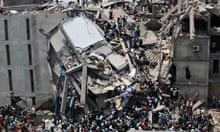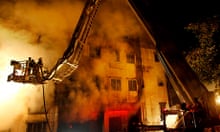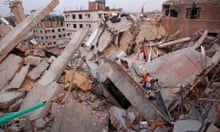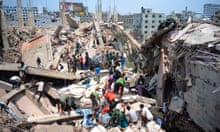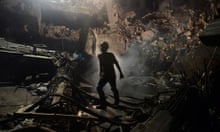A woman has been rescued from the rubble of a garment factory building in Bangladesh that collapsed 17 days ago killing more than 1,000 people, police and military officials said.
Emergency service workers pulled Reshma Begum, a seamstress who was working on the third floor of the factory when its central portion fell in shortly after the day's work had started, from piles of debris on Friday.
The 24 April disaster, in an industrial zone on the outskirts of the capital Dhaka, is one of the world's worst ever industrial accidents.
The Rana Plaza building developed cracks before collapsing but workers were forced to remain inside by management. A number of major western retailers, including British high street giant Primark, were being supplied by factories based in the building.
Around two thirds of over 3,000 workers thought to be in the building at the time of the collapse managed to flee. However, as many as 1,500, according to some estimates, may have been buried by rubble.
With an official death toll standing at 1,050, relatives and rescue workers had given up hope of finding anyone else alive.
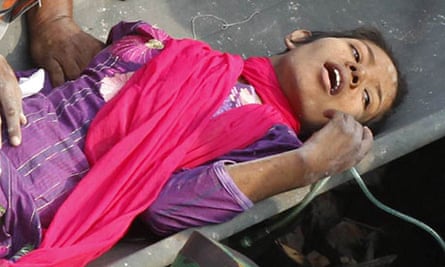
However, around 3pm on Friday workers at the site heard a faint metallic tapping as bulldozers moved in to remove debris covering what had been the basement of the building.
"We were removing slabs," said Lt Col SM Imran-Uz-Zaman, an army spokesman at the site. "We immediately halted work in all other areas and focused on the rescue."
Abdur Razzaq, an army sergeant, said Begum had been hitting the concrete with the pipe to alert approaching rescue workers and he heard the sound after bulldozers lifted loose rubble that had been covering the spot.
"I heard the sound and rushed towards the spot. I knelt down and heard a faint voice. Sir, please help me, she cried," Razzaq told the Guardian.
The woman had been breathing through a pipe from inside the wreckage, Razzaq said, and had sustained no serious injury.
Begum told rescuers she had survived by scavenging for biscuits in the rucksacks of dead colleagues and drinking rainwater.
Handsaws were used to cut her free.
A woman wailing near the wreckage said Begum was her niece.
"We'd only expected to see her body," she cried.
As the woman was lifted from the rubble, crowds at the site broke into cheers of "God is great!" Rescue workers were seen wiping away tears.
Daily life in much of the capital ground to a halt as Dhaka's inhabitants watched the rescue unfold live on local television.
Army officers co-ordinating the rescue expressed astonishment at finding a survivor in the rubble.
"It is incredible that someone could have survived in the wreckage 408 hours after the building came down," Lieutenant Shah Jamal said. "Her will to live is amazing. We've given her oxygen and she has been rushed to hospital."
An earlier bid to rescue a woman found in the debris more than 100 hours after the building collapsed went disastrously wrong when sparks from a saw ignited a fire, killing her and fatally burning a rescue worker.
Nine people have been arrested in connection with the disaster, including the owner of Rana Plaza and owners of the factories it housed.
The disaster has sparked widespread criticism of the international retailers supplied by businesses in Rana Plaza.
The government has blamed the owners and builders of the eight-storey complex for using shoddy construction materials, including substandard rods, bricks and cement, and not obtaining the necessary clearances.
Primark and its Canadian counterpart Loblaw have announced they will compensate the victims of the disaster, the world's worst industrial accident since the Bhopal gas leak in India in 1984.
There have been a series of deadly accidents in Bangladesh's garment industry, which accounts for 80% of the country's exports and employs around 4 million people. There was a fire in November that killed 114 people, while a fire killed eight people at another garment factory in Dhaka earlier this week. That facility is believed to have conformed to local health and safety regulations.
Quake survivors
The discovery of a woman found alive under the rubble of a Bangladeshi factory building, 17 days after it collapsed, is testament to the power of human endurance when seemingly staring death in the face.
Reshma Begum, who worked on the third floor of Rana Plaza, had been breathing through a pipe from inside the wreckage, soldiers conducting the rescue operation said. She told them she had survived by scavenging for biscuits in the rucksacks of dead colleagues. As incredible as her Reshma Begum's story is, a number of other tales of survival provide equally powerful testament to the strength of the human spirit when faced with overwhelming odds.
Naqsha Bibi, then 40, was found amid the wreckage of the Kashmir earthquake in 2005, it was an incredible 63 days after the disaster. She weighed less than 35kg and had been in the same position for so long that doctors said she would need physiotherapy to enable her to "unfreeze" her muscles, which had withered while she was trapped in a crouching position. She had apparently survived on rainwater and rotting food.
A Swedish man, named in media reports as Peter Skyllberg, 44, He was discovered in February last year, having apparently spent two months snowed inside his car as temperatures outside dropped to -30C. He survived by eating snow. Doctors believe he was kept alive by the "igloo effect" of his vehicle, although there has been some scepticism about his story.
In 2007, Evan Muncie,28, a rice vendor, was rescued from the rubble of the Haiti earthquake, 27 days after the disaster struck. Muncie, who was malnourished, delirious and dehydrated but had no serious injuries, said he survived by sipping sewage water that oozed beneath the rubble of the marketplace where he was buried.
His was one of a number of incredible tales of survival from the Haiti quake.A 15-day-old girl, Elisabeth Joassaint was found alive in a crumbled house, a week after the Haiti quake, having spent almost half her life without food or water in a crumbled house. Amid the despair, one of the most memorable images from Haiti was that of Kiki Joachin, seven, greeting rescuers with open arms and a beaming smile as they pulled him out of a collapsed apartment building eight days after the quake. His 10-year-old sister Sabrina also survived but three of their siblings died. "I smiled because I was alive," Kiki said. Darlene Etienne, then 16, was dragged out of the rubble of the Haiti quake after 15 days. She had apparently been having a shower when a wall collapsed on top of her and it was believed that access to water in the room helped save her life.
Pedrito Dy, 27, tried to kill himself after being entombed with corpses in a collapsed hotel in the Philippines for 14 days in 1990. He survived his ordeal after the earthquake by drinking his own urine and drops of rainwater. But he told reporters that on several occasions he had banged his head against concrete beams because "I could not take it any more".
